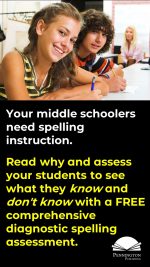10 Reasons Middle School Teachers Should Teach Spelling
As an MA reading specialist and ELA teacher, I spent the last dozen of my 36 years teaching ELA to seventh and eighth graders. At my last middle school, I taught with 14 highly skilled ELA teachers. None of them taught spelling. Some years ago I mentioned in a department meeting that I still taught spelling and my colleagues were curious as to why. I told them that my kids needed it and asked them if their kids needed spelling instruction. They stumbled around a bit, blamed elementary teachers for not doing so, provided anecdotes about Einstein being a poor speller, and finally settled on “We don’t know.”
Seeing the opening, I volunteered to email them the audio file of my diagnostic spelling tests and told them I would correct the tests and show them what their students know and don’t know. They readily agreed. A week later I placed the mastery matrices of the spelling assessments in their teacher boxes. The results clearly indicated that most had a few areas of spelling deficits in terms of spelling patterns. However, some of their students showed many areas of spelling pattern deficits. I suggested to our department chair that we might dedicate a portion of our next department meeting to brainstorming how we might address those deficits. That brainstorming session never took place. I did brainstorm why with some of my reading specialist buddies. They provided reasons why middle school teachers were not interested in teaching spelling (mainly because they did not know how), but also why they should be teaching spelling to their students.
10 Reasons Middle School Teachers Should Teach Spelling
1. Intermediate, upper elementary, and middle school teachers are not doing their jobs teaching spelling. Take a look at the yellow chart. Clearly, beginning readers in grades 1 and 2 tend to score similarly on reading comprehension and spelling. However, as intermediate teachers (grades 3 and 4) tend to assume that all necessary phonics skills have been mastered, they also tend to stop teaching the other side of the decoding coin: encoding (spelling). The results for middle school spellers are undocumented by research; however, teachers would certainly agree that middle schoolers do not reverse the trend.
2. Spelling is not acquired naturally through wide reading It’s not caught; it must be taught.
3. Spelling is not a primary skill; it is a literacy skill for all ages.
4. Spelling is not a genetic predisposition. Once a bad speller, not always a bad speller.
5. You can teach middle schoolers spelling. Spelling is more predictable than many middle school teachers think. Spelling expert, Dr. Louisa Moats, estimates that 84% of English words either directly correspond to their sound-spellings or do so with an additional spelling rule (https://www.aft.org/sites/default/files/periodicals/Moats.pdf.) Plus, middle school students can catch up while they keep up with grade-level spelling. Remedial spelling skills are teachable.
6. Spelling helps with reading. According to Catherine Snow, the real importance of spelling for reading as follows: “Spelling and reading build and rely on the same mental representation of a word. Knowing the spelling of a word makes the representation of it sturdy and accessible for fluent reading” (https://www.readingrockets.org/article/how-spelling-supports-reading).
7. Spelling aids vocabulary development. This is especially true with respect to Greek and Latin prefixes, suffixes, and roots: the meat of middle school orthography.
8. Spelling helps with writing. Teachers often underestimate the amount of mental muscle expended by poor spellers attempting to select words which they can substitute for difficult spellings. Dictionaries take too much time, including online ones. Spell check is less than 80% accurate.
9. Teaching spelling (both grade level and remedial) does not take much instructional time and produces immediate pay-off for students.
10. Spelling matters. Poor spellers are brutally bullied and suffer considerable discrimination. A misspelled word on an employment application almost always dooms an applicant. Want to be the subject of a meme? Misspell a word. Think about how many puzzles and games require good spelling. Poor spelling is equated with lack of intelligence by a majority of Americans.
*****
My take? Synthetic phonics is the most efficient means of teaching the alphabetic code and should be taught systematically as part of any beginning reading program or reading intervention program. However, good reading and spelling programs provide additional analytic phonics activities, such as syllabication and spelling pattern word sorts. Plus, while most students learn with a synthetic approach, others respond best with an analytic approach. Good teachers also use incidental embedded phonics instruction as teachable moments to study words in depth as they use shared and guided reading. The best means of determining whether any method of reading instruction is working? Assessment. Flexible teachers use data to inform instruction and the instructional approach to meet the needs of individual students.
Get the Diagnostic Reading and Spelling Assessments FREE Resource:
The author’s Differentiated Spelling Instruction provides quality spelling programs for grades 4, 5, 6, 7, and 8. Following are the program components:
- Diagnostic Spelling Assessment: a comprehensive test of each previous grade level spelling pattern to determine what students know and what they don’t know with Spelling Assessment Mastery Matrix
- 102 Remedial Sound-Spelling Worksheets Corresponding to the Diagnostic Spelling Assessment (Grade 8… other grade levels have fewer to correspond with grade-level spellings. All grade levels use the same diagnostic assessment.)
- Weekly Diagnostic Spelling Tests
- Weekly Spelling Sort Worksheets for Each Spelling Pattern (with answers) formatted for classroom display. Students self-correct to learn from their own mistakes.
- Syllable Transformers and Syllable Blending formatted for classroom display and interactive instruction
- Syllable Worksheets (with answers) formatted for classroom display
- Four Formative Assessments (given after 7 weeks of instruction)
- Summative Assessment
- Spelling Teaching Resources: How to Study Spelling Words, Spelling Proofreading Strategies for Stories and Essays, Syllable and Accent Rules, Outlaw Words, 450 Most Frequently Used Words, 100 Most Often Misspelled Words, 70 Most Commonly Confused Words, Eight Great Spelling Rules, Memory Songs and Raps (with Mp3 links), and Spelling Review Games
Read one of our customer testimonials: “I work with a large ELL population at my school and was not happy with the weekly spelling tests, etc. Through my research in best practices, I know that spelling patterns and word study are so important at this age group. However, I just couldn’t find anything out there that combines the two. We have just adopted RtI at my school and your spelling matrix is a great tool for documentation. The grade level spelling program and remediation are perfect for my students.”
Heidi




